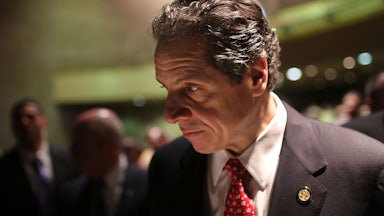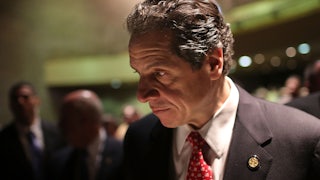On Tuesday, Andrew Cuomo announced his resignation as governor of New York. In his address to the state, he continued to deny the allegations of sexual harassment detailed in Attorney General Letitia James’s report and refused to take responsibility for his actions. The problem, he explained, was that he could see no way to move forward despite his innocence. “This situation and moment are not about the facts. It’s not about the truth. It’s not about thoughtful analysis. It’s not about: How do we make the system better?” he said. “This is about politics, and our political system today is too often driven by the extremes.”
Cuomo wasn’t alone at the press conference. His announcement was preceded by a statement by his personal lawyer, Rita Glavin. The strategy was simple: Maybe you wouldn’t believe Cuomo, but here was Glavin claiming her legal and feminist bona fides—“I think that women should be believed”—while denouncing the report and state investigators “as the prosecutors, the judge, and the jury of Governor Cuomo.” Glavin’s role was a familiar trope during Cuomo’s time in office: a powerful woman acting as a shield for the governor and his abuses. A form of representational politics and optics sharpened to a point that could draw blood. It was, it turns out, his strategy until the end.
As the report itself details, Cuomo used his power and the power of his office to coerce women, push their boundaries, and touch them inappropriately. But he didn’t act on his own: The report also outlines the many ways in which his administration’s top aides, many of them women, systematically worked to enforce a toxic workplace and to silence anyone who came forward with complaints that might endanger their boss and, with him, their own powerful positions. That wall of protection was clear to the people around the governor: As Charlotte Bennett, one of Cuomo’s accusers, said of senior staff: “I have no concept of how far they’d go to protect him and didn’t want to find out.”
On Monday, Melissa DeRosa, Cuomo’s top aide, resigned from the administration, another sure sign that the political fallout for the governor was becoming untenable. The Cuomo administration has long touted his track record on reproductive rights and marriage equality as a way to deflect criticism of his progressive performance. (He did the same in his resignation speech, reciting exactly the same issues as further vindication of the kind of man he is.) But the report, which captures the actions of an abusive man, also outlines in staggering detail how the systems and people supporting these men, including several high-profile women aides, were able to weaponize feminism, gender, and progressive optics to silence victims and perpetuate abuse. If the Cuomo report and his resignation are a lesson in anything, it’s that the right policies, and women in leadership positions, will never be enough. Change isn’t a matter of finding the right gatekeepers—it’s about the end of gatekeeping.
DeRosa and other top aides used a range of tactics to protect Cuomo, and themselves, at all costs, including trying to discredit Lindsey Boylan, one of the governor’s accusers, by orchestrating a campaign to leak her personnel file to the press to undermine her credibility. DeRosa also drafted and circulated an unpublished letter to disparage Boylan, which was reviewed by multiple people, including Roberta Kaplan, the chairwoman of Time’s Up, a celebrity-driven group that formed in the wake of the Harvey Weinstein abuse revelations and raises money for victims of sexual harassment.
But the report shows the more nebulous ways in which the culture of fear upheld by Cuomo’s top aides protected abuse. Boylan, for example, testifies about how DeRosa would scream and curse her out and she attempted, on multiple occasions, to resign from the executive office. Brittany Commisso, an executive assistant who claimed that Cuomo had harassed her, including reaching under her blouse and groping her breast, testified that after the governor asked her to take a photo with him and not to share it with anyone aside from another executive assistant, she was terrified specifically of Cuomo’s top aides finding out. “If Stephanie Benton or Melissa [DeRosa] heard that, I was going to lose my job. Because I knew that I certainly was going to be the one to go.” Bennett explains in the report how she went to great lengths to smooth things over with DeRosa and Benton, sending them an email complimenting them, which was something she did “out of desperation to ‘make it seem like everything was totally fine.’” All of this supports recent reporting on the administration’s toxic workplace environment: “Most people I spoke to about their relationships with the governor have memories of being yelled at, threatened, or insulted by senior female colleagues, especially Melissa DeRosa,” New York magazine’s Rebecca Traister reported in March.
The powerful women who work for Cuomo have long deflected any criticism of their actions by decrying such criticism as misogynistic. “Haven’t you heard? Women aren’t allowed to be mad or fight—being tough and direct makes you a ‘bitch,’” DeRosa tweeted last month. In his response to the report, Cuomo himself made the same case: “A number of complaints target female managers, which smacks to me of a double standard. A strong male manager is respected and rewarded. A strong female manager is ridiculed and stereotyped. It is a double standard. It is sexist. And it must be challenged.” Lis Smith, a political consultant, also recently defended DeRosa by claiming that she faced a double standard. It’s often touted by the governor and his allies that DeRosa is on the chair of the New York State Council on Women and is the first woman in history to serve as secretary to the governor, as if one cannot abuse power while also occupying a powerful position. (“I’m very proud of the fact that I have more women in senior positions than any governor before me,” Cuomo said during his Tuesday resignation press conference, true until the end. “The lack of diversity on the state police detail was an ongoing disappointment for me.”)
These deflections aren’t just public-facing; they’re also utilized in everyday ways behind the scenes. When reporters from the Albany Times Union asked the executive office about how Cuomo got a young female state trooper whom he harassed reassigned to his protective detail, despite the fact that she didn’t meet the previous criteria—three years on duty—for the position, DeRosa accused them of sexism for even going down this line of inquiry. “You guys are trying to reduce her hiring to being about looks. That’s what men do,” DeRosa said.
The harassment in Albany went unchecked for so long in part because these tactics often work. During the pandemic, DeRosa had been the subject of multiple glowing write-ups in women’s magazines—Harper’s Bazaar included her in a summer roundup of “voices of hope,” and a profile in Elle on DeRosa’s role in the administration’s coronavirus response read: “You can thank her for getting help to those who need it most.” (Later, it was reported that DeRosa helped the administration cover up the extent of Covid deaths in nursing homes.)
None of this was new. In October 2017, just a few weeks after The New York Times and The New Yorker published their investigations detailing decades of sexual coercion and violence at the hands of Harvey Weinstein, DeRosa was invited to deliver the keynote speech at a Women in Media conference hosted by Berkeley College. Reflecting on the Weinstein news, DeRosa spoke personally—she recounted the sexism she had faced in her career, and how misogyny “isn’t something women read or talk about in the abstract.” She continued: “We live it, and we know it when it happens, and all too often we don’t say anything.”
DeRosa went on to emphasize that she herself was lucky to work in an administration that “so highly values its female employees,” and listed policies that the governor had worked on to protect women’s rights in health care and on college campuses. The implication was that there was a distinction between the conditions of DeRosa’s workplace—where she was a powerful official, evidence itself of how much the administration valued women—and the rest of the state, where Cuomo’s office had to work to “further advance equality.”
Now the veil is, in some ways, being lifted, and not only with Cuomo’s resignation; on Monday, Kaplan, the lawyer who was involved in the Cuomo administration’s effort to discredit Boylan, resigned from Time’s Up after a group of former staffers and clients published an open letter saying that the organization was “failing all survivors” and had “lost its way.” The revelation reinforced once again the superficiality of the feminism behind high-profile efforts to combat harassment. “Time’s Up has prioritized its proximity to power over mission,” the letter reads. But in the same way that removing harassers from office is only just a start, last-minute resignations from women like Kaplan and DeRosa are far from sufficient. And in the same way that it was no surprise that the Cuomo administration’s bullying, power-playing, and backdoor style of politics created a toxic workplace environment, the type of oppositional “feminism” wielded by women like DeRosa and other top Cuomo aides has always been transactional and self-serving.
This pattern has been a long-held tension in feminism. From the wars around Sheryl Sandberg’s Lean In to the pushback around celebrating powerful women like Hillary Clinton for shattering glass ceilings while being an enforcer of the structural inequities that keep millions of women locked into systems of poverty and violence, the question as to what feminism demands and whom it is for continues to be the central one. The fallout around Cuomo’s resignation and the question of where to go next will revolve around similar fights over what a just future will actually mean.
The powerful women who surrounded Cuomo until the end worked as gatekeepers who upheld institutions of violence and retaliation. Now we need to push for the kinds of structural and labor-oriented reforms that will take down the gates and bring about real accountability. As Melissa Gira Grant wrote in March, when the sexual harassment allegations against the governor first broke: “To the extent that people conceptualize sexual harassment as existing on a continuum of gender-based violence, it tends to cloud over the fact that it also exists on a continuum of labor abuses.” But we also have to stop being dazzled over and over again by the flashy idea of women in high places as any answer to the problems at hand—something that is already beginning as Cuomo’s replacement, Lieutenant Governor Kathy Hochul, is now being touted as the “first woman governor” in the state’s history. We shouldn’t content ourselves with such easy narratives about change.
As DeRosa herself said in her 2017 keynote speech: “I’m not sure which I find more offensive—the fact that this kind of behavior has been allowed to continue to go on as long as it has, or the idea that everyone is acting as if they are just now finding out about it.”








